Further reading
- Favier, Jean. Charlemagne. Tallandier: Paris, 2019.
- Hodgkin, Thomas. Italy and her Invaders. Clarendon Press: 1895.
- Oman, Charles. The Dark Ages 476–918. Rivingtons: London, 1914.
Hrodgaud or Rodgand was the Duke of Friuli from 774 to 776. In all likelihood he was already duke under Desiderius, notwithstanding some Frankish sources, such as the Einhardis annales , who say that Charlemagne put him in power after the Siege of Pavia.
In 776, he rebelled against his lord and, according to some, declared himself king. Charlemagne, however, had been forewarned of the revolt by Pope Hadrian I, who himself had been warned in a letter by John, Patriarch of Grado. Hadrian believed that a conspiracy of Lombards and Byzantines, led by Arechis II of Benevento, Hildeprand of Spoleto, and Raginald of Clusium, was brewing against the Franks. Thus, Charles quickly crossed the Alps and defeated him, retaking Friuli and Treviso, where he spent Easter, killing Hrodgaud and replacing him with Marcarius. He placed Frankish counts in the cities of Friuli.
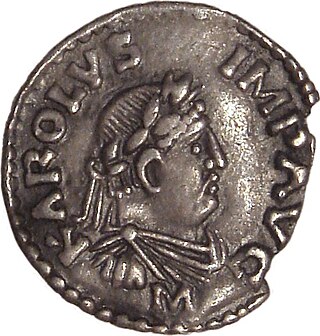
Charlemagne was King of the Franks from 768, King of the Lombards from 774, and Emperor from 800, all until his death. Charlemagne succeeded in uniting the majority of Western and Central Europe, and he was the first recognized emperor to rule Western Europe after the fall of the Western Roman Empire approximately three centuries earlier. Charlemagne's rule saw a program of political and societal changes that had a lasting impact on Europe in the Middle Ages.

Louis I, better known as Louis the Pious, also called the Fair and the Debonaire, was King of the Franks and co-emperor with his father, Charlemagne, from 813. He was also King of Aquitaine from 781. As the only surviving son of Charlemagne and Hildegard, he became the sole ruler of the Franks after his father's death in 814, a position that he held until his death except from 833 to 834, when he was deposed.
Pope Adrian I was the bishop of Rome and ruler of the Papal States from 1 February 772 to his death. He was the son of Theodore, a Roman nobleman.
The 770s decade ran from January 1, 770, to December 31, 779.

Year 776 (DCCLXXVI) was a leap year starting on Monday of the Julian calendar. The denomination 776 for this year has been used since the early medieval period, when the Anno Domini calendar era became the prevalent method in Europe for naming years.

Desiderius, also known as Daufer or Dauferius, was king of the Lombards in northern Italy, ruling from 756 to 774. The Frankish king of renown, Charlemagne, married Desiderius's daughter and subsequently conquered his realm. Desiderius is remembered for this connection to Charlemagne and for being the last Lombard ruler to exercise regional kingship.
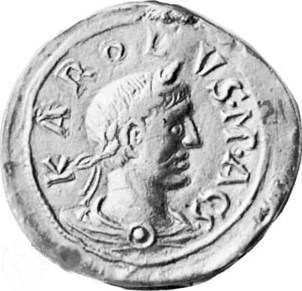
Charles III, also known as Charles the Fat, was the emperor of the Carolingian Empire from 881 to 887. A member of the Carolingian dynasty, Charles was the youngest son of Louis the German and Hemma, and a great-grandson of Charlemagne. He was the last Carolingian emperor of legitimate birth and the last to rule a united kingdom of the Franks.

Pepin, born Carloman, was the son of Charlemagne and King of Italy (781–810) under the authority of his father.
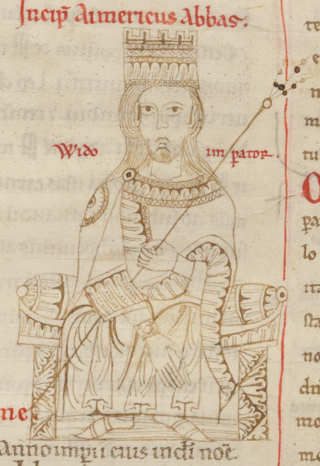
Guy III of Spoleto was the margrave of Camerino from 880 and then duke of Spoleto and Camerino from 883. He was crowned king of Italy in 889 and emperor in 891. He died in 894 while fighting for control of the Italian Peninsula.

Arechis II was a Duke of Benevento, in Southern Italy. He sought to expand the Beneventos' influence into areas of Italy that were still under Byzantine control, but he also had to defend against Charlemagne, who had conquered northern Italy.
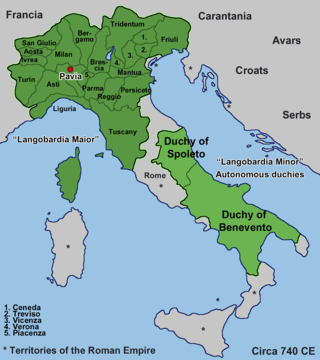
The Duchy of Friuli was a Lombard duchy in present-day Friuli, the first to be established after the conquest of the Italian peninsula in 568. It was one of the largest domains in Langobardia Major and an important buffer between the Lombard kingdom and the Slavs, Avars, and the Byzantine Empire. The original chief city in the province was Roman Aquileia, but the Lombard capital of Friuli was Forum Julii, modern Cividale.
Hildeprand was the Duke of Spoleto from 774 to 789. He married Regarde, daughter of Gotfrid.
Marcarius was the Duke of Friuli from 776 to 787. He was the first Friulian duke appointed by Charlemagne after the rebellion of the Lombard Hrodgaud. He was probably not a Lombard. He played a minor part in the Schism of the Three Chapters.
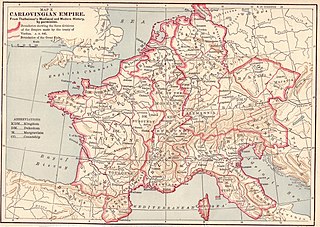
The March of Friuli was a Carolingian frontier march, established in 776 as the continuation of the Lombard Duchy of Friuli, established against the Slavs and Avars. It was ceded to the Duchy of Bavaria as the March of Verona in 952. Its territory comprised parts of modern-day Italy, Slovenia and Croatia.
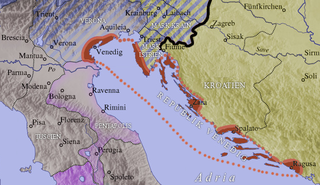
The March of Istria was originally a Carolingian frontier march covering the Istrian peninsula and surrounding territory conquered by Charlemagne's son Pepin of Italy in 789. After 1364, it was the Istrian province of the Habsburg monarchy, the Austrian Empire and Austria-Hungary.

The March of Carinthia was a frontier district (march) of the Carolingian Empire created in 889. Before it was a march, it had been a principality or duchy ruled by native-born Slavic princes at first independently and then under Bavarian and subsequently Frankish suzerainty. The realm was divided into counties which, after the succession of the Carinthian duke to the East Frankish throne, were united in the hands of a single authority. When the march of Carinthia was raised into a Duchy in 976, a new Carinthian march was created. It became the later March of Styria.
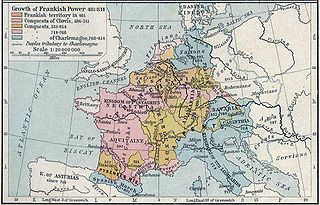
The siege of Trsat was a battle fought over possession of the town of Trsat in Liburnia, near the Croatian–Frankish border. The battle was fought in the autumn of 799 between the defending forces of Dalmatian Croatia under the leadership of Croatian duke Višeslav, and the invading Frankish army of the Carolingian Empire led by Eric of Friuli. The battle was a Croatian victory, and the Frankish commander Eric was killed during the siege.
Probatus was the Abbot of Farfa from 770 until 781, and the first abbot native to the Sabina. He steered the abbey through the fall of the Kingdom of the Lombards, trying to prevent the disastrous aggression of its last king, and kept it from falling under the jurisdiction of either the Papacy or the Papal States. With the benefit of his local connections he oversaw a great expansion of the abbey's properties through grants and purchases, and also rationalised its holdings to create a robust base for an early medieval monastic community.

Gerold was a franconian nobleman who served the Frankish King, Charlemagne, as Margrave of the Avar March and Prefect of Bavaria in what is now South-Eastern Germany. Gerold played a significant role in the integration of Bavaria into the Frankish Kingdom during Carolingian expansion in the late 8th, and early 9th centuries. Gerold both aided the continuity of Agilofing rule of Bavaria, as well as took steps to integrate Bavarians into the wider scope of the Frankish Kingdom. Gerold was related both to the Agilofing family, the ruling class of Bavaria, as well as the Carolingian family. The Agilofings had ruled Bavaria since Duke Garibald I in 548. Gerold was born into the Agilofings, and his sister Hildegard was married to Charlemagne in 771. From these familial connections, he was appointed Prefect of Bavaria following the deposition of Duke Tassilo III in 788. Gerold was heralded as a superb military commander, giving rise to his promotion to Prefect as a defender of the eastern border of the Frankish Kingdom. In 799, Gerold is said to have fallen in battle against the Avars, shortly after the same Avars killed his ally, Eric, Duke of Friuli, through treachery.
Leo I was archbishop of Ravenna from A.D. 770, following a disputed election, until his death in A.D. 777. Archbishop Leo played an important role in the arrest of Paul Afiarta and was the subject of letters from Pope Hadrian I to Charlemagne collected in the Codex Carolinus and dated from late 774.